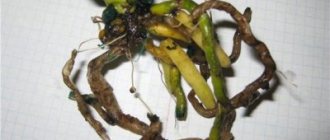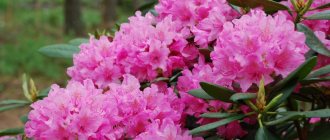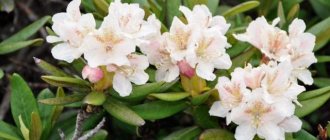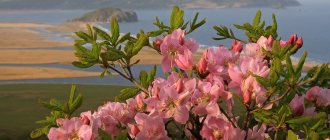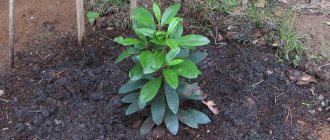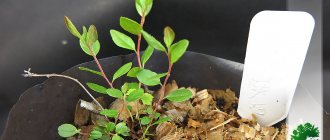When you look at this bush, you immediately associate it with a large pink tree. This is absolutely true, and this is how the word rhododendron is translated from Greek. Basically, the name consists of two separate words - “rhodon”, meaning “rose” and “dendron”, meaning “tree”. Rhododendron is a plant that has confidently won the hearts of both experienced gardeners and beginner amateurs. The luxurious and fairly long-lasting flowering of this gorgeous bush will not leave anyone indifferent.
History of the garden plant rhododendron
One of the most striking representatives of the Heather family, rhododendron (Rhododendron), is represented by shrubby plants and trees. If you read the species definition, there are:
Gorgeous rhododendron bush
- evergreen;
- deciduous;
- semi-deciduous.
Different sources describe different numbers of plants in this genus. On average, it unites from 800 to 1300 plants, including azaleas, which are very popular in indoor floriculture.
For reference: among domestic flower lovers it is the azalea that is usually called “indoor rhododendron.”
Fertilizer and feeding of rhododendron
In the first year, transplanted plants already require careful fertilizer, which is applied in a highly diluted form, in small portions. The plant itself will signal the need to apply fertilizer: it will stop growing, shed its foliage or the leaves will change color, and the formation of flower buds will stop.
Organic fertilizer for feeding rhododendron bushes is semi-decomposed manure that needs to be infused in water. Feeding is carried out with an aqueous solution of manure. To increase the formation of flower buds, as well as extend the flowering period, granular superphosphate, or double superphosphate, is used, which is scattered on the moist soil under the plants. Feeding the plant with microelements is also beneficial - fertilizers are applied in the form of watering or spraying the green mass of the bush. It is necessary to intensively fertilize the bushes until the end of August.
Rhododendron before flowering
Where is rhododendron common?
When does hydrangea bloom - flowering period, how long does it bloom
In nature, it grows mainly in the Northern Hemisphere - the territories of Southern China, the Himalayas, Southeast Asia, North America and Japan. Some representatives are found in the Far East and the Caucasus; they also grow in the climatic conditions of Ukraine. They can be located singly, or in whole groups.
Most often they prefer the northern slopes of the mountains, along which they can climb to the alpine zones. The plant needs high air humidity and a little shade from other shrubs or trees.
It is interesting that in modern botany two genera of plants have been combined - wild rosemaries and rhododendrons. As a result, the plant, which was called “swamp wild rosemary,” was renamed “rhododendron.” So, the Ural wild flowering rhododendron is now national pride and a symbol of the inhabitants of central Russia.
In central Russia, semi-evergreen and deciduous plant species take root best. When grown in the garden, they almost never exceed 1.5–2 m in height, although rhododendrons in nature can be much taller. Crown can be:
- ellipsoid;
- spherical;
- branched.
Marsh wild rosemary
Planting a plant
Rhododendron: planting and caring for plants in compliance with agrotechnical rules - plant replanting is allowed in spring and autumn. In autumn - in any of three months, in spring - in warm, settled weather, when the soil is no longer frozen (usually April or May).
The choice of place for planting a plant must be done with special care. Rhododendron plantings should be protected from the prevailing wind and direct sunlight. It is important that the shrub is accessible for viewing, then the decorative appearance of the plant during the flowering period will decorate the area and please the eye.
Tip: before planting a plant from a container into open ground, it should be thoroughly saturated with water.
The planting hole for rhododendron bushes is prepared based on the actual size of the root system, and should be 2 times larger in volume. Natural soil should be completely removed. To plant a plant, you need to prepare a special soil consisting of equal parts of heather soil; peat; garden soil or leaf humus; rotted manure; needles (pine).
It is very important to plant the plant correctly, then it will quickly take root.
The prepared hole is filled with the mixture, and a place is prepared in it for planting a rhododendron bush, which must be placed strictly vertically. The soil around the root system of the plant must be compressed tightly; the formation of voids and “pockets” in the planting soil is not allowed. If the groundwater level is high, provision should be made for laying a special drainage layer at the bottom of the pit. The top layer of soil after planting should be mulched with peat chips.
Selecting a location
Seedlings need diffused shade to grow well. In open areas you can grow Canadian, Daurian, Kamchatka varieties of shrubs. Young plants are protected from the wind by artificial fences. Bushes should not be in direct sunlight - it is better to plant them under a spreading tree.
Seedling preparation
Before planting Bloombux seedlings in a permanent place, they need to be saturated with moisture. Water is poured into a large container, to which potassium permanganate or any root growth stimulator can be added, and the plant is immersed in it. First, air bubbles will appear, indicating that the root system is filling with moisture.
Soil preparation
The acidity level of the soil is the most important characteristic for planting rhododendron.
The optimal pH is from 4.5 to 5.5.
If there is excess acidity, the plant may develop chlorosis. The parameter is checked before planting with litmus paper. You can oxidize the soil with commercial soil for rhododendrons.
Landing rules
Planting stages:
- First, a hole is dug under the Bloombux rhododendron with a depth of at least 40 cm and a diameter of about 60 cm. To fill it, you will need nutritious soil consisting of 3.5 buckets of loam and 8 buckets of high-moor peat. The soil is thoroughly mixed.
- Drainage is placed at the bottom, then a third of the soil. The mass is compacted well to remove voids.
- Then the Bloombooks rhododendron seedling is placed vertically in the center and sprinkled with the remaining soil. The soil is compacted again so that there are no air pockets left between the roots. The root collar does not need to be buried; it should remain above the surface.
- Rhododendron Bloombux requires good watering, the main thing is that the soil is wet 20 cm deep.
- To retain moisture, mulch is laid out in the tree trunk circle. These can be oak leaves, pine needles, peat or moss. Mulch thickness – 5-6 cm.
Advice! Often, a planted rhododendron seedling already has the rudiments of buds. It is recommended to pick them, as flowering will worsen the possibility of rooting.
When planting several Bloombux rhododendron seedlings in a row to create a hedge or in single plantings, it is necessary to provide supports and tie the bushes so that the wind does not loosen the root system. Before installing the support, you need to determine the direction of the wind and tilt it towards it.
Watering
The shrub does not tolerate drought or excessive moisture. It is recommended to water it with soft filtered water or rainwater. You can reduce the hardness of the liquid by adding a couple of handfuls of peat to the liquid for 24 hours. Water the plant when the leaves become less elastic and faded. The earth should not dry out. The optimal amount of watering is 1-2 times a week.
Weeding
Weeds are pulled out by hand - a hoe can damage the root system. Instead of weeding, you can carefully treat the soil with herbicides. When treating the soil with chemicals, try not to spray them on the rhododendron. Weeds are eliminated manually monthly.
Watering and fertilizing
If it rains constantly in the summer, then the Bloombooks rhododendron will not need watering. In dry times, the bushes need to be irrigated at least every other day. The depth of soil wetting is at least 15 cm. Watering is carried out early in the morning or evening hours.
Important! In the fall, before the onset of frost, it is necessary to carry out moisture-recharging irrigation.
It is recommended to regularly weed out weeds, but under no circumstances should you loosen the soil. These are the biological characteristics of rhododendrons.
Rhododendron Bloombux grows well in soil rich in humus and organic matter. Immediately after planting, it is recommended to water the seedlings with Argumin solution so that the plant takes root faster. To avoid yellowing, planting leaves are fed with a solution of Iron Chelate.
And now about the annual feeding regime:
- In early spring, organic fertilizers containing nitrogen are added to the bushes. If mineral fertilizers are used, then for each square. m you need to add magnesium sulfate (50 g) and ammonium sulfate (50 g).
- After the end of flowering, you again need to add potassium sulfate (20 g), superphosphate (20 g) and ammonium sulfate (40 g) to each square.
- In July, Bloombux rhododendron bushes are fed with potassium sulfate and superphosphate, 20 g of each fertilizer per square meter. m.
Warning! It is not recommended to feed rhododendrons with lime, wood ash, or fertilizers that can deoxidize the soil.
Landing in the ground
A pit with a diameter of 0.7 m and a width of 0.6 m is prepared in 3–4 weeks and filled with fertile substrate. You can prepare it yourself (mix 8 buckets of high-moor peat and 3.5 buckets of loam) or purchase a store-bought soil mixture. After pouring out, the fertile substrate is compacted.
Landing algorithm:
- Make a small hole.
- Immerse the seedling in a container of water.
- Place the root system in the hole and then carefully fill it with substrate.
- Water the plant thoroughly.
- Fill the area around the tree trunk with natural mulch (pine needles, oak leaves, etc.).
Popular varieties and varieties
It is recognized that approximately 40 species of this shrub can grow in central Russia.
Why rhododendron does not bloom in open ground in the garden: what to do
The lush inflorescences of the bushes consist of 20-30 flowers, shaped like bells. The inflorescences are located at the ends of the branches. Surrounded by dark green glossy leaves, the inflorescences resemble huge bouquets. In the middle zone they are considered one of the first shrubs to bloom in spring. The types of this popular shrub should be considered based on their foliage.
Evergreens are distinguished by the fact that in winter, such rhododendron does not shed its leaves, but simply rolls them into a tube, unfolding them when a comfortable temperature is established outside.
The most popular evergreen shrubs include the following species:
- Katevbinsky;
- grandiflorum;
- Pontic;
- roseum elegans;
- Alfred.
Semi-evergreen species include:
- Sikhote-Alinsky;
- ledebura.
The most popular deciduous varieties are rightfully considered:
- Daurian;
- yellow;
- Japanese;
- Canadian;
- Kamchatka;
- dense.
All varietal species differ from each other in the splendor of flowering, variety of colors and shapes.
This is interesting: in some places there are even rhododendrons in the form of fairly large trees, comparable in size to an apple tree.
Types and varieties of rhododendrons with photos
A photo of a blooming rhododendron is always impressive. Therefore, the alpine rose is especially popular, but only a few species are used to grow this elegant beauty in the garden.
When choosing a variety, take into account the characteristics of the region and climate. Rhododendron is more common: hybrid, Dahurian, Adams, Japanese, Caucasian, etc. Rhododendron is a rather whimsical plant. If agricultural technology is violated, it may die.
Dahurian rhododendron (Rhododendron dahuricum)
This variety is common in China and eastern Siberia. According to the description, Daurian rhododendron is an evergreen shrub with a strong, highly branched crown. Rhododendron dahuricum can be up to 4 m. It is distinguished by gray bark. The branches of the plant are directed upward. Thin shoots have a brown-red color and are covered with small pile.
Sheet length 3 cm. Plate with glossy front part. The reverse side is covered with scales. Young foliage is pale green. Gradually the plates darken. Closer to autumn, the leaves turn brown.
Blooms magnificently for 20 days. The buds bloom before the buds open. Funnel-shaped flowers. Large buds can reach 4 cm in diameter. The petals are pink-violet.
In autumn the shrub blooms again.
Daurian rhododendron is frost-resistant and propagates by young cuttings. Several varieties of it are grown: evergreen and early hybrid. The latter are low-growing bushes with large (up to 5 cm in diameter) flowers. Petals can be red and blue. Early hybrid Rhododendron dahuricum is less resistant to frost.
Good to read: Lily is a royal flower, a serious competitor to roses.
Adams Rhododendron (Rhododendron Adamsii)
The homeland of this species is the Far East, Tibet. Grows up to 1.5 meters. The shoots are covered with small hairs - glandular pile.
The leaves are oblong. Their length reaches 20 mm. The leaves are dense and green. The front surface is smooth, the back surface is covered with reddish-colored scales. The scutes include up to 15 buds. Flowers are up to 1.5 cm in diameter. The petals are pink.
Japanese rhododendron (Rhododendron japonicum)
Rhododendron japonicum is native to the island of Honshu. Grows on sunny mountain slopes. It is classified as deciduous, grows no more than 2 m. The crown is branched. The branches are bare, covered with silvery bristles. The leaf blades are lanceolate. The leaves are covered with soft hair on the back and front sides.
With the onset of cold weather they acquire a red-orange hue.
Inflorescences include 6-12 flowers. The buds are bell-shaped, 8 cm across. The petals are scarlet-red, but there are also orange tints. Rhododendron flowers exude a fragrant aroma. Japanese rhododendron in the garden is grown in mid-latitudes and is frost-resistant. For its propagation, cuttings and seeds are used.
Caucasian rhododendron (Rhododendron caucasicum)
This variety of rhododendron grows in the Caucasus. An evergreen species of small size, creeping along the ground. The leaves are dark green, leathery, oblong, oval in shape. The front surface of the plates is smooth, the back surface is covered with red fibers. The leaves are held on thick petioles.
Peduncles are hairy in the shape of brushes. Inflorescences include 8-10 buds. The flowers exude a fragrant aroma and are funnel-shaped or bell-shaped. In the wild, Caucasian rhododendron is found with pale green flowers, the throat of which is covered with green spots.
In decorative species, the petals can be pink-white, dark pink and shiny, golden yellow with pale green spots, straw yellow with light red specks.
An article about chrysanthemums, spectacular plants with original forms of inflorescences.
Rhododendron hybrid
This variety of rhododendrons includes all hybrids cultivated by gardeners. In the photo, this species of rhododendron looks impressive. Most often you can find:
Alfred . The height of the plant can reach 1.2 m. The leaf blades are dark green with a glossy surface, oblong. Inflorescences contain 15-20 dense buds. The petals have a rich purple hue. The throat is covered with green-yellow speckles. The buds can reach 6 cm in diameter;
Blue Peter . Shrub from 1.5 meters high. The diameter of the crown reaches up to 2 m. The buds are lavender in color, up to blue, and large. Petals with corrugated edge. A purple spot can be seen at the top of the petals;
Jacksony . It grows up to 2 m. The crown diameter is about 3 m. There is a low-growing variety that can grow up to 80 cm. The leaves are oblong oval in shape. The front side of the leaf plates is green and matte, the back side is brown. Inflorescences include 8-12 buds. As they open, the petals are pink and then turn white. A pale yellow spot forms on one of the petals in the bud.
No less popular varieties are Rose Marie, Nova Zembla, and Cunningham.
How long does rhododendron bloom?
Gardeners are often interested in the question of how long rhododendron blooms. The timing of flowering of a shrub is influenced primarily by climatic conditions, region of growth, plant variety and its condition. In most cases, the flowering period begins in April and ends in June.
Caucasian rhododendron in the mountains: when to bloom
Early flowering shrubs open the flowering period (April, May), then evergreen species pick up the baton and the flowering season ends with deciduous species.
How long rhododendron blooms also directly depends on a particular variety. In general, flowering lasts 15-20 days, but some shrubs can delight with gorgeous inflorescences from 30 to 45 days. In addition to the variety, the following factors also influence the flowering time:
- brightness and amount of light;
- air temperature;
- soil saturation with nutrients.
Important! Rhododendron is one of the obstinate plants. Therefore, in order not to experience bitter disappointment and not to destroy the plant in your garden, you need to familiarize yourself with all the intricacies of caring for it.
Rhododendron care
You cannot loosen the soil around the plant - the procedure will damage its root system. In spring, you need to protect the foliage from direct sunlight with gauze or netting. For the successful development of shrubs, mulching of tree trunk circles is required.
In warm autumn, the plant can produce buds, but the young shoots do not ripen and die in winter. Spraying the bushes with a 1% solution of potassium sulfate or monosulfate will help avoid the problem. Spraying them will lead to lignification of the shoots.
Watering
The shrub does not tolerate drought or excessive moisture. It is recommended to water it with soft filtered water or rainwater. You can reduce the hardness of the liquid by adding a couple of handfuls of peat to the liquid for 24 hours. Water the plant when the leaves become less elastic and faded. The earth should not dry out. The optimal amount of watering is 1-2 times a week.
Weeding
Weeds are pulled out by hand - a hoe can damage the root system. Instead of weeding, you can carefully treat the soil with herbicides. When treating the soil with chemicals, try not to spray them on the rhododendron. Weeds are eliminated manually monthly.
Top dressing
The plant constantly needs nutrients. Rhododendron fertilization begins in early spring and ends at the end of July after flowering has completed. Rotted cow manure can be used for feeding. It is diluted in water (ratio – 1:15). The resulting solution is kept for 2–3 days. Before applying fertilizer, the shrub is watered abundantly.
Mineral supplements for rhododendron:
- superphosphate;
- magnesium and calcium sulfate;
- potassium nitrate, sulfate, phosphate;
- ammonium sulfate and potassium.
Fertilizer with nitrogen is added in early spring. After flowering, each square meter of soil is treated with a mixture of 20 g of potassium sulfate with superphosphate or 40 g of ammonium sulfate. The procedure is repeated in July. Intensive fertilization of bushes ends in August.
Trimming
The bushes do not require artificial formation. Periodically dried branches are pruned to rejuvenate the plant. In a small area, the procedure regulates the size of the bushes. Perform pruning in early spring. After the procedure, treat the branches with garden varnish.
When pruning, you need to leave at least 75% of the bush: if you remove too many shoots, the plant will dry out.
Diseases and pests
The bushes are damaged by slugs or snails, which eat the foliage and destroy the buds. You will have to eliminate the pests manually. To prevent repeated attacks by mollusks, the plant is treated with an 8% solution of TMTD VSK or another combined fungicide. When infested with ticks, bedbugs, and weevils, Diazinon is used. Flies, scale insects, mealyworms are destroyed with Karbofos. If the soil is poorly ventilated, fungal diseases affect rhododendron:
- chlorosis;
- rust;
- cancer;
- leaf spotting.
Diseased shoots are removed. When the leaves turn yellow, use iron chelate: the substance is added to the water for irrigation. Instead, you can use iron sulfate or citric acid. To prevent fungi, at the beginning of spring or at the end of autumn, shrubs are sprayed with Bordeaux mixture. Preparations based on copper sulfate will get rid of rust and leaf spot.
What colors are rhododendrons?
Rhododendron is the largest shrub in terms of diversity of species. Therefore, you can easily choose a bush that matches the color of your landscape design. For example, if you need a blue, lilac or purple bush, inflorescences of these shades are:
- attractive;
- Katevbinsky;
- dense;
- merrin;
- Canadian;
- Pontic.
If you prefer red flowers, you should pay attention to the inflorescences:
- Kamchatka;
- blood red;
- Albrecht;
- rusty.
Pink inflorescences in:
- Canadian;
- Daurian;
- the largest.
The Japanese variety will delight you with salmon and orange flowers.
And here are the yellow flowers:
- nail-shaped;
- yellow;
- golden.
The following inflorescences will delight you with white and cream flowers in the garden:
- short-fruited;
- Atlantic;
- sticky;
- Adams;
- tree-like;
- Caucasian.
You can always choose a variety that will optimally fit into the overall landscape design of any site.
Description of rhododendron
Rhododendron growing in the garden is most often a large shrub. The shape and size of its crown and leaves vary significantly and depend on the specific species. It is thanks to its beautiful foliage and spectacular delicate flowers that rhododendron is so valued in gardening. Its flowers are collected in inflorescences-brushes or corymbs. Due to the number of flowers, each inflorescence resembles a small bouquet.
The color palette includes pink and lilac, as well as tones of white, yellow and red. The appearance of individual flowers may also vary between species. Flowers are tubular, funnel-shaped, wheel-shaped. In some varieties they resemble a bell. Some rhododendrons emit a pleasant smell during flowering. The period of bud blooming usually occurs in spring, turning rhododendron into one of the early honey plants. After the flowers wither, boxes filled with tiny seeds form in their place.
RHODODENDRON - planting and care // All the secrets of lush flowering
Chemical composition
It is important to know about rhododendron that it is a poisonous plant. The dangerous properties are associated with a substance contained in the composition called andromedotoxin (also called rhodotoxin, acetylandromedol).
Varietal rhododendron at home
This cyclic diterpene is classified as polyhydroxylated. According to the mechanism of action, it is comparable to neurotoxins and is characteristic of almost all Heathers.
The action of this toxic substance is based on the ability to disrupt the functioning of cellular receptors. Initially, the central nervous system is excited, and then comes into a state of depression. This mechanism of action is quite capable of leading to death. This information is not known to everyone, but it eliminates all doubts about whether the rhododendron bush is poisonous or not.
Choosing a location on the site
Successful cultivation of rhododendrons involves choosing a suitable location, preparing the soil and planting the plant correctly.
Deciduous rhododendrons need a lot of light; in the shade they will grow, but bloom poorly. Evergreen species require shade from midday sun. But all rhododendrons need protection from drying winds. Places near buildings or fences, tall trees or shrubs are suitable for planting. The bushes are positioned so that in winter snow does not fall on them from the roof of the house. Rhododendrons have superficial roots, so neighbors of rhododendrons should not be trees with the same structure of the root system - birch, linden, willow, maple, chestnut, spruce. Oak, larch, pine will not interfere with rhododendrons - their roots grow deep, as well as fruit trees - apple, pear, and cherry trees.
Decorative use
Not a single gardener, having once seen this flowering shrub, will deny himself the pleasure of planting it on his site. Many believe that it is incomparable to any other decorative flowering plant. And if many call the rose the queen of the garden, then the rhododendron is deservedly called its king.
The year a young rhododendron blooms after planting is influenced by many circumstances - applied fertilizers, weather conditions, care. A high decorative effect can be achieved already from the first year of planting seedlings by purchasing large-sized plants aged 5-8 years with a formed crown and flower buds ready to bloom.
Also, the effect in decorative use largely depends on exactly how the plant is located on the site.
Important! Since rhododendron grows for a long time, you need to buy either mature bushes, or immediately expect that it will show itself in all its glory decades later.
How to transplant a rhododendron to a new place
The main signal for replanting is the unsatisfactory condition of the shrub for several years: it blooms poorly, overwinters unsuccessfully, and takes a long time to recover.
In this case, a change in the location of the rhododendron is required:
- Take the necessary tools: a shovel, a pitchfork, a wheelbarrow.
- If the soil is dry, then it is slightly moistened so that the dug root ball does not crumble.
- Dig a rhododendron bush to the width of the crown or a little more to a depth about the bayonet of a shovel.
- Carefully remove the rhododendron with a lump using a fork, trying not to damage the roots.
- The plant is loaded into a wheelbarrow and transported to a new prepared place.
- Carefully transfer the bush from the wheelbarrow into the hole.
Important! For better adaptation in a new place, it is advisable to maintain the orientation of the plant towards the sun so that it coincides with the original position of the plant.
Rhododendron in the landscape
It is considered a universal ornamental plant. This is especially true for the period when rhododendron is in bloom and bright inflorescences cover the bush from top to bottom.
The plant looks great both in group plantings and as a tapeworm against a background of emerald green grass. It goes well with many types of decorative flowering and decorative foliage plants.
In landscape design it is used to create a hedge. Universal in uniform plantings. Often used for planting near artificial ponds or streams.
Planting in open ground
For 2-3 year old bushes, planting holes are prepared with a diameter and depth of 30 cm. For adult plants, holes are dug with a diameter of 60 cm and a depth of 40 cm. Drainage is arranged at the bottom of the planting holes - pieces of broken red brick or coarse gravel are placed, spilled with water, then pour the prepared loose substrate. Do not plant in ordinary garden soil or pure peat. The soil is prepared from a mixture of garden soil with high-moor peat, rotted pine needles, sand, and a small part of compost or humus.
The substrate is watered so that it settles a little. Before planting, the roots are immersed in water and held until the formation of air bubbles stops. Rhododendron is planted in the ground at the level of the root collar, and after planting the bush is watered and mulched with a mixture of peat, sand and crushed pine bark.
What diseases does rhododendron treat?
In medicine, a description of the phytoncidal, bacterial, and insecticidal properties of this plant has long been compiled. Tannins and ascorbic acid were identified in it. It is obvious that the plant has medicinal properties. Products containing it are used as:
Rhododendron flowers for making medicines
- antipyretic;
- diaphoretic;
- painkiller.
Shows good results in the treatment of diseases of the cardiovascular system. It is rich in substances that increase the power of heart contractions and, accordingly, increase blood flow.
With the help of this plant, problems with:
- rheumatism;
- chronic colitis;
- vegetative neuroses;
- epilepsy;
- uterine erosion;
- a cold.
In folk medicine, infused leaves of the plant are mainly used.
Important! Considering the completely harmless substances contained in the leaves, the plant should be used at home with extreme caution. It is important to ensure that the child does not drink the infusion.
Useful properties of rhododendron
Rhododendron is not only a very beautiful, but also a useful shrub. It has a number of medicinal properties that allow it to be used in medicine both for the creation of official medicines and for folk remedies. Many types of rhododendron contain andromedotoxin, arbutin and a special substance rhododendrin. The foliage of the shrubs is rich in ascorbic acid. This composition gives the plant the properties of an analgesic, antipyretic and sedative. In addition, it can fight bacteria, help remove excess moisture from the body and relieve swelling. Rhododendron can also reduce blood pressure and improve heart function.
But self-medication should be avoided. It should also be remembered that not everyone can use rhododendron-based preparations. They are not recommended for patients with kidney disease or tissue necrosis. Pregnant women and nursing mothers should also not rely on the flower. Any products containing rhododendron substances require the approval of a doctor.
Garden flowers Perennial flowers
How to grow rhododendron from seeds at home
Propagation by seeds is the main thing for this shrub. Plant cuttings have a weaker root system, and the bush does not become bulbous at all. Sowing is done in January. Rhododendron seeds are small; they are sown on the surface of previously prepared soil. In order for them to germinate, the following rules must be followed:
- temperature regime − +25 °С;
- mandatory lighting;
- spraying with a spray bottle - daily;
- ventilation.
Important! When the first shoots appear, you need to start fertilizing with weak solutions of fertilizers specifically designed for this type of shrub.
Strong seedlings of rhododendron bushes are planted either in a greenhouse or in open ground, depending on weather conditions. The theory of how to grow rhododendron from the smallest seeds is not complicated, the main thing is to strictly follow all the recommendations.
Reproduction methods
Seed propagation is possible only for species or varieties. Hybrids are propagated vegetatively. If you need few new plants, it is better to make several layerings so as not to bother with cuttings.
Seeds
Rhododendrons are sown in wide shallow bowls on the surface of a damp peat-sand mixture. Sprinkle with clean washed and calcined sand. Cover with glass and keep in light at high humidity and temperature. Ventilate daily.
Rhododendron seedlings usually hatch within a month. After 2 true leaves appear, they are picked, grown in a greenhouse for the first year, then transplanted into a schoolhouse. They will bloom in the 6-8th season.
Cuttings
Semi-lignified cuttings are suitable for propagating rhododendrons. They are cut into 5-8 cm pieces, all leaves are torn off except the top ones, the lower part is treated with a stimulant, and rooted in a mixture of peat and sand. You can use a greenhouse with high temperature and humidity, or cover the planting with a glass cover.
The lower shoots will appear:
- in deciduous species - after 6 weeks;
- evergreen rhododendrons produce roots after 3-4.5 months.
The cuttings are grown in a mixture of peat and pine litter (2:1). In winter, they are kept in good light and a temperature of 8-12 ° C. In spring, the seedling box is buried in an area in partial shade. They are transplanted to a permanent place after 2 years.
Bends
In the spring, a strong shoot located in the lower part of the bush is selected on the rhododendron. It is bent down and buried at least 15 cm deep. The top is tied to a peg, and the part of the shoot directed towards the mother plant is pinned to the ground so as not to be accidentally pulled out.
Water abundantly and often. The next season, the cuttings are separated from the bush and transplanted to a permanent place.
Juice from petals of rhododendron dahurian
Scientists have discovered the following beneficial substances in the petals of the plant:
Daurian rhododendron
- fructose;
- phytoncides;
- resins;
- essential oils;
- vitamins A, C, E.
It is not surprising that the juice from this amazing plant, which is also called rosemary, is used in medicine. In combination with fresh cream, juice obtained from the petals treats:
- stomach and duodenal ulcers;
- thrombophlebitis;
- wound surfaces.
Having learned what rhododendron is and having become familiar with all the growing and care conditions necessary for the plant, you can decide whether it is worth planting it on your site.
Rhododendron: planting and care in cold climates
In order not to be disappointed in growing rhododendron in the middle zone, it is important to choose the right variety. There are many cold-resistant deciduous varieties, adapted even for the climatic zone of the Urals and Siberia. Caring for rhododendron includes a number of rules that even a beginner can follow:
- Maintain the acidity of the soil, preventing ash, dolomite flour, and lime from getting into the soil.
- Do not loosen the soil around the planting; instead, it is better to use mulching.
- Provide protection from direct sunlight, covering with cloth or gauze if necessary.
- Use a standard irrigation scheme.
Garden azalea - planting and care in open ground
When planting rhododendron, proceed as follows:
- Choose a suitable place, at a distance of at least 1 meter from other trees, whose roots may compete with the plant in the fight for moisture.
- Prepare the soil by mixing peat with garden soil and pine needles, and additionally apply mineral fertilizer with a complex composition.
- Prepare a planting hole and, if necessary, fill it with drainage.
- Place the root ball of the seedling in the hole so that the seedling itself assumes a strictly vertical position.
- Fill the prepared soil around the rhizome without deepening the root collar of the bush - it should be at ground level.
- The soil is compacted and watered.
Attention! In the autumn, prolonged rains can provoke the growth of young shoots that do not have time to ripen before the onset of cold weather and die.
To prevent their appearance, the bush is sprayed with potassium monophosphate or sulfate. After spraying, watering the plant is prohibited, even if the weather is dry.
Care
More attention should be paid to rhododendrons after flowering. As soon as the inflorescences fade, they are cut off with pruning shears. This is necessary so that the rhododendron does not waste energy on ripening the seeds and does not feed the drying brushes.
This species blooms brightly, but not for long - about a month, some varieties for only 2 weeks. After this, the plant recovers and gains nutrients for the winter stage of bud maturation. Many beginners do not know that the most important thing for flowering is its preparation, and this happens in autumn-winter.
For the sake of buds, rhododendrons are fed in the fall with acidic phosphorus-potassium fertilizers and organic matter is added to renew the fertile humus layer. The recommended composition for spring is superphosphate 100 g, ammonium sulfate 90 g, potassium sulfate 4 g, magnesium 2 g. For autumn application, ammonium sulfate is not required, but the amount of potassium sulfate is increased to 9 g.
In the fall, before the bush goes into hibernation, water-charging watering is done so that the roots receive a supply of water. Wet soil freezes less, and water dissolves nutritional components that will be useful in the spring, because the rhododendron wakes up under the snow. Winter drying out is one of the problems that inexperienced rhododendron breeders may encounter.
Trimming
There is no special need to trim rhododendrons, since they all have the correct spherical shape. Pruning is carried out if some shoots are frozen and the buds on them have died. Bacteria can penetrate into such places, so the cut is treated with garden pitch or copper sulfate.
It is better to remove branches growing inside the bush so as not to create crowding. If light penetrates into the crown, the plant will bloom more luxuriantly.
Old bushes that have grown greatly are pruned - this rejuvenates the tree, but such an activity must be carried out carefully, as it greatly weakens the plant. In the first year, one half of the bush is pruned, in the second year the second. You can stretch out the pruning for 3 years to injure the plant less - then it will continue to bloom.
Rhododendrons have the peculiarity of blooming every other year. This happens due to a lack of nutrients. The bush accumulates them, then forms flower stalks. The next year it rests and again accumulates nutrients. If you make it a rule to feed every year in the fall, there will be no “failures” in flowering.
To prevent the bush from wasting fertilizer, it is recommended to immediately remove all faded inflorescences with pruning shears.
Loosening the soil
It is not recommended to loosen the soil under the rhododendron even by hand, especially since you cannot use a pitchfork, shovel, or metal pins for this purpose. The location of the roots does not allow this to be done safely, so it is better to correctly mix the soil mixture when planting.
Weeds in an area with rhododendrons will grow only those that are adapted to acidic soil. Remove them by hand from the roots.



